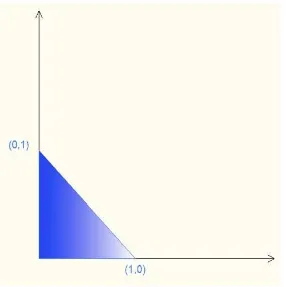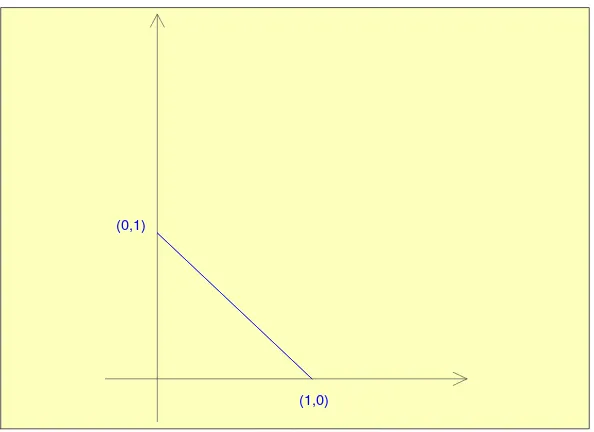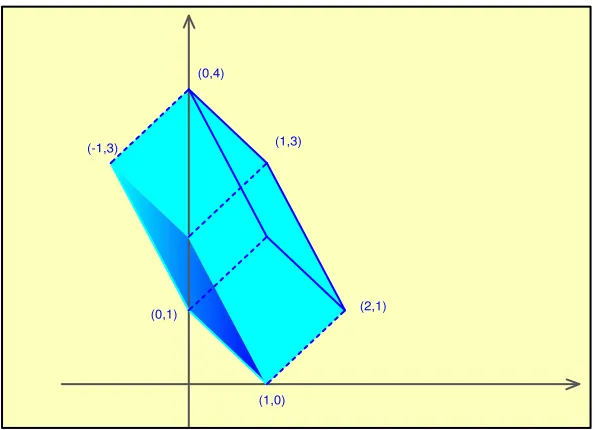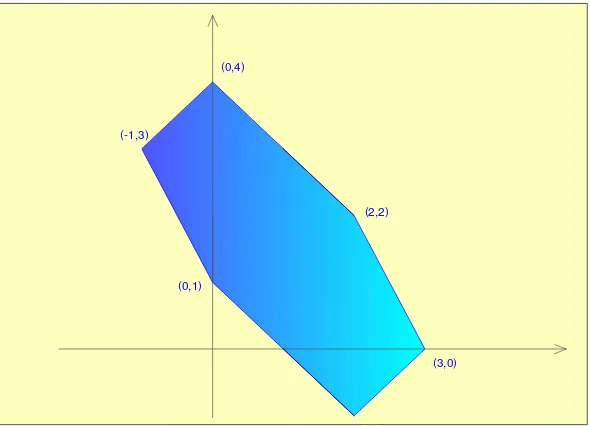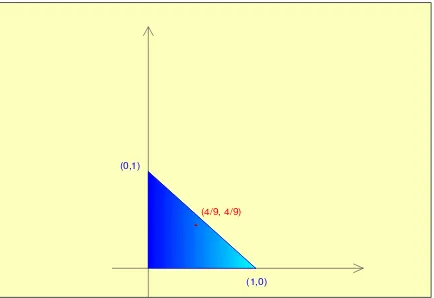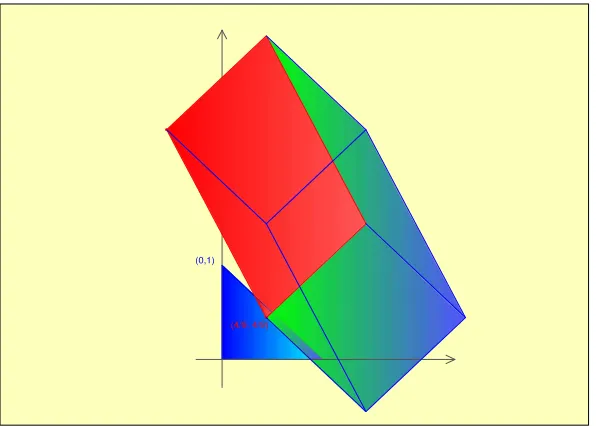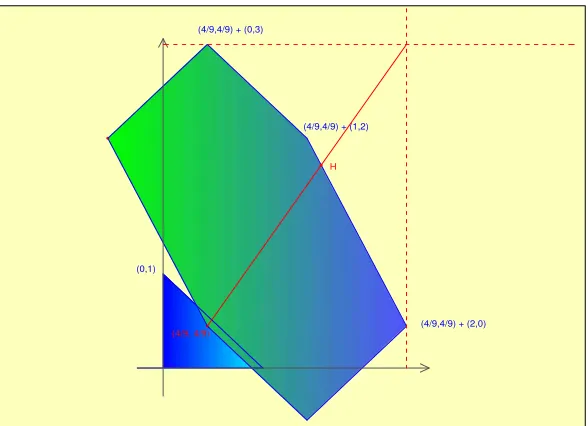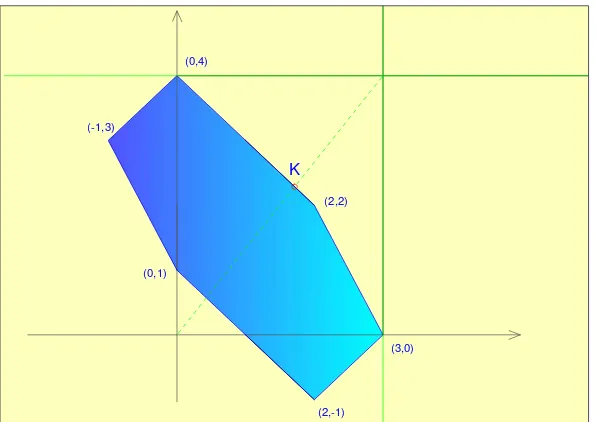Munich Personal RePEc Archive
Global green economy and environmental
sustainability: a coopetitive model
Carfì, David and Schilirò, Daniele
DESMaS "V.Pareto" Università degli Studi di Messina
March 2012
Online at
https://mpra.ub.uni-muenchen.de/37018/
Global Green Economy and Environmental Sustainability:
A Coopetitive Model
David Carf`ı*, Daniele Schilir`o**
*Department of Mathematics University of California at Riverside
900 Big Springs Road, Surge 231 Riverside, CA 92521-0135, USA. **Department DESMaS,
University of Messina,
Via Tommaso Cannizzaro 275, Me 98122, Messina, Italy.
*davidcarfi71@yahoo.it **danieleschiliro@unime.it
Abstract.
This paper provides a coopetitive model for a global green economy taking into account the environmental sustainability. In particular we propose a differentiable coopetitive game
G(in the sense recently introduced by D. Carf`ı) to represent a basic green economy inter-action among a countrycand the rest of the worldw. Our gameGis a linear parametric (Euclidean) perturbation of the classic Cournot duopoly. In the paper we offer the com-plete study of the proposed model and in particular a deep examination of its possible coopetitive solutions.
Keywords:Complete analysis of an infinite game; coopetitive games; global green econ-omy; environmental sustainability.
1
Introduction
A major driver of human impact on Earth systems is the destruction of biophysical resources. The accelerating carbon emissions, in particular, indicate a mounting threat of climate change with potentially disastrous human consequences. The total environmental impact of a community or of humankind as a whole on the Earths’s ecosystems depends both on population (which is increasing) and impact per person, which, in turn, depends in complex ways on what resources are being used, whether or not those resources are renewable, and the scale of the human activity relative to the carrying capacity of the ecosystems involved.
1.1 Environmental Sustainability (ES)
Thus, we are facing a problem of environmental sustainability (ES). Goodland (2005) defines ES as the maintenance of natural capital. ES emphasizes the environmental life-support systems without which neither production nor humanity could exist. These life-support systems include atmosphere, water and soil; all of these need to be healthy, meaning that their environmental service capacity must be maintained. So ES can be represented by a set of constraints on the four major activities regulating the scale of the human economic subsystem: the use of renewable and nonrenewable resources on the source side, and the pollution and waste assimilation on the sink side. This is why ES implies that careful resource management be applied at many scales, from economic sectors like agriculture, manufacturing and industry, to work organizations, to the consumption patterns of households and individuals and to the resource demands of individual goods and services.
1.2 Geopolitical situation
important and urgent measures that must be adopted at a global level. The economic and geopolitical events are changing the international context and also the costs of energy supply in the world industrialized nations. The financial and economic crisis of 2008, in particular, has caused a widespread disillusionment with the prevailing economic paradigm, and has determined a stronger attraction for the green economy.
1.3 Green Economy
The green economy is an economy concerned with being:
1. environmentally sustainable, based on the belief that our biosphere is a closed system with finite resources and a limited capacity for self-regulation and self-renewal. We depend on the earths natural resources, and therefore we must create an economic system that respects the integrity of ecosystems and ensures the resilience of life supporting systems.
2. Socially just, based on the belief that culture and human dignity are precious resources that, like our natural resources, require responsible stewardship to avoid their depletion.
3. Locally rooted, based on the belief that an authentic connection to place is the essential pre-condition to sustainability and justice. The global green economy is an aggregate of individual communities meeting the needs of its citizens through the responsible production and exchange of goods and services.
Thus global green economy growth is compatible with environmental sustainability over time, since it seeks to maintain and restore natural capital .
1.4 The coopetition
This paper applies the notion of coopetition within a macro-global context for environmental problems . The concept of coopetition is a complex construct originally devised by Brandenburger and Nalebuff (1995, 1996), Stiles (2001) in strategic management at microeconomic level.
According to this concept, the economic agents (i.e. firms or countries) must interact to find a win-win solution, that indicates a situation in which each agent thinks about both cooperative and competitive ways to change the game. So in our case, each country has to decide whether it wants to collaborate with the rest of the world in getting an efficient global green economy, even if the country is competing in the global scenario.
1.5 Our model
The coopetitive model here suggested is environmentally sustainable, since it should lead to
maintain natural capital, by using mainly renewable resources. This ES coopetitive model also aims at reducing emissions of greenhouse gases, determining the reduction of global pollution, in this way it contributes to the establishment of a sustainable and lasting global green economy. Finally, the model determines a change in the patterns of consumption of households towards goods and human behaviors with a lower environmental impact. So the coopetitive strategy, in our model, consists in implementing a set of policy decisions whose purpose is to be environmental sustainable and to enforce the global green economy. This is why the coopetitive variable in our model is represented by a vector variable whose components guarantee the achievement of the environmental sustainability of a global green economy. Thus, this original ES coopetitive model, applied at the global green economy, aims to enrich the set of tools for environmental policies.
Strategies. The coopetitive strategies in our ES coopetitive model are:
1. investment in maintenance of natural renewable resources;
2. investment in green technologies against pollution (air, water);
3. incentives and taxes to change the patterns of consumption of the households.
2
The model: an ES coopetitive model of Economy
The coopetitive model we propose hereunder must be interpreted as a normative model, in the sense that it will show the more appropriate solutions and win-win strategies chosen within a cooperative perspective, under precise conditions imposed by assumption.
2.1 Strategies
The strategy sets of the model are:
1. the set E of strategies x of a certain country c - the possible aggregate biological-food
production of the country c - which directly influence both payoff functions, in a proper
game theoretic approach´a la Cournot;
2. the set F of strategies y of the rest of the word w - the possible aggregate biological-food
production of the rest of the worldw- which influence both pay-off functions;
3. the set Cof 3-dimensional shared strategiesz, set which is determined together by the two
game players,cand the rest of the worldw.
Interpretation of the cooperative strategy. Any vector z in C is the 3-level of aggregate
investment for the ES economic approach, specificallyz is a triple (z1, z2, z3), where:
1. the first componentz1 is the aggregate investment, of the countryc and of the rest of the
worldw, inmaintenance of natural renewable resources;
2. the second componentz2 is the aggregate investment, of the countrycand of the rest of the
worldw, ingreen technologies against pollution;
3. the third componentz3is the aggregate algebraic sum, of the countrycand of the rest of the
worldw, ofincentives (negative) and taxes (positive) to change the patterns of consumption
of the households.
In the model, we assume thatcandwdefine ex-ante and together the setCof all cooperative
strategies and (after a deep study of the coopetitive interaction) the triplezto implement as a
possible component solution.
2.2 Main strategic assumptions
We assume that any real numberx, in the canonical unit intervalE :=U= [0,1], is a possible
level of aggregate production of the countrycand any real number y, in the same unit interval
F:=U, is the analogous aggregate production of the rest of the worldw.
Measure units of the individual strategy sets. We assume that the measure units of the two
intervalsE andF be different: the real unit 1 inE represents the maximum possible aggregate
production of countrycof a certain biological product and the real unit 1 inF is the maximum
possible aggregate production of the rest of the wordw, of the same good. Obviously these two
units represents totally different quantities, but - from a mathematical point of view - we need
Cooperative strategy. Moreover, a real triple (3-vector) z, belonging to the canonical cube
C := U3
, is the 3-investment of the country c and of the rest of the world w for new
low-carbon innovative technologies, in the direction of sustainability of natural resources and for the environmental protection.
Also in this case, the real unit 1 of each factor ofC is, respectively:
1. the maximum possible aggregate investment in maintenance of natural renewable resources;
2. the maximum possible aggregate investment in green technologies against pollution (air, water);
3. the maximum possible aggregate algebraic sum of incentives and taxes to change the patterns of consumption of the households.
Let us assume, so, that the country and the rest of the world decide together, at the end of
the analysis of the game, to contribute by a 3-investmentz= (z1, z2, z3).
We also consider, as payoff functions of the interaction between the countrycand the rest of
the wordw, twoCournot type payoff functions, as it is shown in what follows.
2.3 Payoff function of country c
We assume that the payoff function of the countrycis the functionf1of the unit 5-cubeU
5
into the real line, defined by
f1(x, y, z) = 4x(1−x−y) +m1z1+m2z2+m3z3= 4x(1−x−y) + (m|z),
for every triple (x, y, z) in the 5-cube U5
, where m is a characteristic positive real 3-vector
representing the marginal benefits of the investments decided by countrycand by the rest of the
worldwupon the economic performances of the country c.
2.4 Payoff function of the rest of the world w
We assume that the payoff function of the rest of the worldw, in the examined strategic
inter-action, is the functionf2of the 5-cube U5into the real line, defined by
f2(x, y, z) = 4y(1−x−y) + (n|z),
for every triple (x, y, z) in the 5-cube U5 , where n is a characteristic positive real 3-vector
representing representing the marginal benefits of the investments decided by countryc and the
rest of the worldwupon the economic performances of the rest of the worldwitself.
Remark. Note the symmetry in the influence of the pair (m, n) upon the pair of payoff
functions (f1, f2).
2.5 Payoff function of the coopetitive game
We have so build up a coopetitive gain game G = (f,≥), with payoff function f : U5 → R2,
given by
f(x, y, z) = (4x(1−x−y) + (m|z),4y(1−x−y) + (n|z)) =
= 4(x(1−x−y), y(1−x−y)) +z1(m1, n1) +z2(m2, n2) +z3(m3, n3) =
= 4(x(1−x−y), y(1−x−y)) +Xz(m:n),
for every triple (x, y, z) in the compact 5-cube U5
, where (m:n) is the 3-family of 2-vectors
((mi, ni))
3
i=1= ((m1, n1),(m2, n2),(m3, n3))
and where
X
z(m:n) :=
3
X
i=1
zi(mi, ni)
denotes the linear superposition (linear combination) of the family (m : n) by the system of
3
Study of the game
G
= (
p,
≥
)
Note that, fixed a cooperative strategyzin the cube U3
, the gameG(z) = (pz,≥), with payoff
functionpz, defined on the squareU2 by
pz(x, y) =f(x, y, z),
is the translation of the gameG(03) by the vector
v(z) =Xz(m:n),
so that we can study the gameG(03) (03is the origin of the Euclidean 3-space) and then we can
translate the various information of the gameG(03) by the vector v(z).
So, let us consider the gameG(03). This gameG(03) has been studied completely in D. Carf`ı
and E. Perrone [6] (2012). The conservative part in the payoff space (the part of the payoff
space greater than the conservative bi-value (0,0)) is the canonical 2-simplexT, convex envelope
of the origin and of the canonical basis eof the Euclidean plane R2
[image:6.612.175.461.296.583.2]. This conservative part is represented in the following figure.
Fig. 1.The conservative part of the Cournot payoff space, i.e. the positive part of the imagep0(U 2
).
Dynamical interpretation of coopetition. In what follows we are interested in the trajectory
of the dynamic path generated by the above conservative part T in the co-opetitive evolution
determined by the functionf. The multi-time dynamic path we are interested in is the set-valued
function
γ:U3→R2:z7→Γ(z),
whereΓ(z) is the conservative part of the game G(z). The trajectory is nothing but the union
3.1 Payoff space and Pareto boundary of the payoff space of G(z)
The Pareto boundary of the payoff space of thez-section normal-form gameG(z) is the segment
[e1, e2], with end points the two canonical vectors of the Cartesian vector plane R
2
, translated by the vector
v(z) =Xz(m:n),
this is true for all 3-strategyzin the unit cubeU3
(3-dimensional set).
3.2 Payoff space of the co-opetitive game G
The payoff space of the co-opetitive game G, the image of the payoff function f, is the union of
the family of payoff spaces
(pz(U
2
))z∈C,
that is the convex envelope of the of points 0,e1,e2, and of their translations by the vectors:
– v(1,0,0) = (m1, n1);
– v(1,1,0) = (m1, n1) + (m2, n2);
– v(1,1,1) = (m1, n1) + (m2, n2) + (m3, n3).
3.3 The construction of the Pareto maximal coopetitive path
We show, in the following five figures, the construction of the coopetitive payoff space in three
steps, in the particular case in which m = (−1,1,1) and n = (2,1,−1), just to clarify the
procedure. Moreover we shall consider here only the coopetitive spaceS generated by the Pareto
maximal boundaryM2= [e1, e2], since the Pareto Maximal boundary of the coopetitive gameG
is contained in this partS.
[image:7.612.197.494.444.660.2](1,0) (0,1)
(1,0) (-1,3)
[image:8.612.169.467.99.310.2](0,1) (0,2)
Fig. 3.First step:S1:=M2+U(−1,2).
(0,4)
(1,3)
(2,1)
(1,0) (-1,3)
(0,1)
[image:8.612.168.467.452.667.2](2,2)
(2,-1)
(3,0) (0,4)
(-1,3)
[image:9.612.198.494.99.309.2](0,1)
Fig. 5.Third and final step:S3:=M2+U(−1,2) +U(1,1) +U(1,−1).
(2,2)
(2,-1)
(3,0) (0,4)
(-1,3)
(0,1)
[image:9.612.198.493.454.667.2]The Pareto maximal boundary of the payoff spacef(U5
). The Pareto maximal boundary
of the payoff spacef(U5
) of the coopetitive gameGis the union of segments
[P′ , Q′
]∪[Q′ , R′
],
where the pointP′ is (0,4), the point Q′ is (2,2) and the point R′ is (3,0); as our figures are
showing.
4
Solutions of the model
4.1 Properly coopetitive solutions
In a purely coopetitive fashion, the solution of the coopetitive gameGmust be searched for in
the coopetitive dynamic evolution path of the Nash payoff N′ = (4/9,4/9). Let us study this
coopetitive dynamical path. We have to start from the Nash payoff N′ and then generate its
coopetitive trajectory
N :=N′
+U(−1,2) +U(1,1) +U(1,−1).
A purely coopetitive solution is obtainable by cooperating on the setC and (interacting)
com-peting´a la Nash in a suitable best compromise gameG(¯z), where the cooperative strategy ¯z is
suitably and cooperatively chosen by the two players, by solving a bargaining problem. To be more precise, we give the following definition of properly coopetitive solution.
Definition (of purely coopetitive solution.We say that a triplet= (x, y, z)is a properly coopetitive solution of a coopetitive game G = (f,≥) if its image f(t) belongs to the maximal Pareto boundary of the payoff Nash Path ofG.
Interpretation. The complex game just played was developed with reference to the strategic
triple (x, y, z), and the functional relation f, which represents a continuous infinite family of
games´a la Cournot, where in each member-game of the family the quantities are the strategies
which vary in order to establish the Cournot-Nash equilibrium, and where the vector z allows
the game to identify possible cooperative solutions in a competitive environment, thus we have
obtained apure co-opetitive solution.
4.2 Construction of the Nash path
As before, we can proceed step by step, as the following figures just show.
(1,0) (0,1)
[image:10.612.205.422.521.670.2](4/9, 4/9)
(0,1)
[image:12.612.169.467.98.311.2](4/9, 4/9)
Fig. 10.Third and final step:N =N′+U(−1,2) +U(1,1) +U(1,−1).
(0,1)
(4/9, 4/9) (4/9,4/9) + (0,3)
(4/9,4/9) + (1,2)
(4/9,4/9) + (2,0)
[image:12.612.168.467.455.668.2](0,1)
(4/9, 4/9) (4/9,4/9) + (0,3)
(4/9,4/9) + (1,2)
[image:13.612.199.493.82.295.2](4/9,4/9) + (2,0) H
Fig. 12.Kalai-Smorodinsky purely coopetitive payoff solution:H.
Kalai-Smorodinsky purely coopetitive payoff solution. We have showed, in the above figure, the Kalai-Smorodinsky purely coopetitive payoff solution with respect to the Nash payoff
(the point H). This is the solution of the classic bargaining problem (∂∗N, N′), where∂∗N is
the Pareto maximal boundary of the Nash path N and the threat point of the problem is the
old initial Nash-Cournot payoffN′. The payoff solutionH is obtained by the intersection of the
part of the Nash Pareto boundary which stays over N′ (in this specific case, the whole of the
Nash Pareto boundary) and the segment connecting the threat pointN′ with the supremum of
the above part of the Nash Pareto boundary.
Kalai-Smorodinsky purely coopetitive TU payoff solution. In this game the Kalai-Smorodinsky purely coopetitive payoff solution is not optimal with respect to the Transferable Utility approach, indeed the TU Pareto boundary of our Nash path is the straight line
N′
+ (0,3) + span(1,−1),
and the payoff H does not belong to this line. The unique point of intersection among this TU
boundary and the segment connecting the threat pointN′
with the supremum of the Nash Pareto
boundary is what we define theKalai-Smorodinsky purely coopetitive TU payoff solution.
4.3 Super-cooperative solutions
We can go further, finding a Pareto solution obtainable by double cooperation, in the following sense: we assume that in the game the two players will cooperate both on the cooperative
3-strategyz and on the bi-strategy pair (x, y).
Super cooperative Nash bargaining solution. The super cooperative Nash bargaining pay-off solution, with respect to the infimum of the Pareto boundary, is by definition the point of the
Pareto maximal boundaryM obtained by maximizing the real functional
whereαis the infimum of the Pareto maximal boundary. In our caseαis the origin of the plane,
so this solution coincide with the medium pointQ′= (2,2) of the segment [P′,(4,0)]. This point
Q′ represents a win-win solution with respect to the initial (shadow maximum) supremum (1,1)
of the pure Cournot game, since it is strongly greater than (1,1).
Super cooperative Kalai-Smorodinsky bargaining solution. The Kalai-Smorodinsky bar-gaining solution, with respect to the infimum of the Pareto boundary, coincide with the
inter-section of the diagonal segment [infM,supM] and the Pareto boundary M itself: the point
K= (12/7,16/7), of the segment [P′, Q′]. This pointK also represents a good win-win solution
with respect to the initial (shadow maximum) supremum (1,1) of the pure Cournot game.
K
(2,2)
(2,-1)
(3,0) (0,4)
(-1,3)
[image:14.612.169.467.226.437.2](0,1)
Fig. 13.Super-cooperative Kalai-Smorodinsky solution in the payoff space:K.
Super cooperative Kalai-Smorodinsky transferable utility solution. The transferable utility solutions of our game in the payoff space are all the payoff pairs staying on the straight line
aff(P′
,Q′
) = (0,4) + span(1,−1),
the feasible TU solutions are those belonging to the segments = [(0,4),(3,1)]. Note, anyway,
that the Kalai-Smorodinsky solution of the bargaining problem (s,02) is again the point K:
the super cooperative Kalai-Smorodinsky transferable utility solution coincides with the super cooperative Kalai-Smorodinsky bargaining solution.
5
Sunk costs
For what concerns the sunk costs, we consider an initial bi-cost (1,1) necessary to begin the ES
approach to the production, so that in a non-coopetitive environment we have a translation by
the vector (−1,−1) of the Nash equilibrium payoff (4/9,4/9). Although we have a bi-loss, in a
co-opetitive environment the gain is strictly greater than the absolute value of the bi-loss, thus
the new super-cooperative Kalai-Smorodinsky solutionK−(1,1) is greater than the old Nash
6
Conclusions
Our coopetitive model has tried to demonstrate which are the win-win solutions of a coopetitive strategic interaction that aims at a policy of Environment Sustainability and to implement a Green Economy. This policy concerns
1. investment in maintenance of natural renewable resources;
2. investment in green technologies against pollution (air, water);
3. incentives and taxes to change the patterns of consumption of the households;
taking into account its sunk costs, and the determination of aggregate output of biological food
of any countryc in a non-cooperative game´a la Cournot with the rest of the world.
Theoriginal analytical elements that characterized our coopetitive model are the following:
1. firstly, we definedzas the cooperative strategy, which is the instrumental 3-vector (3
dimen-sions) of the ES policy;
2. secondly, we adopted a non-cooperative game ´a la Cournot for establishing an equilibrium
bi-level (x, y), that represents the levels of outputs of countryc and of the rest of the world
w;
3. thirdly, we introduced the sunk costs of the ES approach;
4. finally, we suggested not only a pure coopetitive solution, but also two super-cooperative solutions on the coopetitive maximal Pareto boundary of our interaction, adopting the Nash bargaining and the Kalai-Smorodinsky methods, thus obtaining two best compromise solu-tion.
Acknowledgements. The authors wish to thank Dr. Eng. Alessia Donato for her valuable help in the preparation of the figures.
References
1. Baglieri D., Carf`ı D., Dagnino G., 2010. Profiting from Asymmetric R&D Alliances: Coopetitive Games and Firms’ Strategies, paper presented at the 4th Workshop on Coopetition Strategy “Coope-tition and Innovation”, Montpellier, June 17-18, 2010
2. Branderburger A.M., Nalebuff B.J., 1996.Coopetition, New York, Currency Doubleday.
3. Brandenburger, A. M., Nalebuff B.J.,1995.The Right Game: Use Game Theory to Shape Strategy. Harvard Business Review, 64: 57-71, July-August.
4. Carf`ı D., 2009.Payoff space inC1
-games, Applied Sciences (APPS), vol. 11, pp. 1-16.
5. Carf`ı D., 2010.A Model for Coopetitive Games, paper presented at Sing6, Palermo, July 6-9 2010 6. Carf`ı D., Perrone E., 2012.Game complete analysis of symmetric Cournot duopoly, MPRA Paper
35930, University Library of Munich, Germany.
7. Carf`ı D. Ricciardello A., 2012.Topics in Game Theory, Messina, APPS Monographs - Balkan Society of Geometry.
8. Carf`ı D., 2010.A Model for Coopetitive Games, paper presented at Sing6, Palermo, July 6-9 2010 9. Carf`ı D., Schilir`o D., 2011.Crisis in the Euro area: coopetitive game solutions as new policy tools,
TPREF-Theoretical and Practical Research in Economic Fields, summer issue 2011, pg. 23-36. 10. Carf`ı D., Ricciardello A. 2010.An Algorithm for Payoff Space in C1-Games, Atti della Accademia
Peloritana dei Pericolanti, Classe di Scienze Fisiche Matematiche e Naturali, LXXXVIII(1): 1-19. 11. Clarke-Hill C., Li H., Davies B., 2003.The Paradox of Co-operation and Competition in Startegic
Alliances: Towards a Multi-Paradigm Approach, Management Research News, vol.26, pp.1-20. 12. Gulati R., Nohria N., Zaheer A., 2000.Strategic Networks, Strategic Management Journal, 21:
203-215.
13. Padula G., Dagnino G.B., 2007.Untangling the Rise of Coopetition, International Studies of Man-agement and Organization, vol. 37, n. 2, pp. 32-53.
14. Porter M., 1985.Competitive Advantage. Creating and Sustaining Superior Performance, Free Press, New York.
15. Schilir`o D., 2009.Knowledge, Learning, Networks and Performance of Firms in Knowledge-Based Economies. In New Technologies, Networks and Governance Structures, edited by A. Prinz, A. Steenge, N. Isegrei,, Wirtschaft: Forschung und Wissenschaft Bd. 24, Berlin, LIT-Verlag, pp. 5-30. 16. Schilir`o D., 2010.Investing in Knowledge: Knowledge, Human Capital and Institutions for the Long
Run Growth, in Governance Of Innovation, edited by M.J. Arentsen, W. van Rossum, A.E. Steenge, Edward Elgar, Cheltenham, 33-50.
